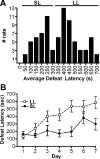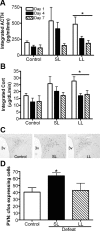Individual differences in reactivity to social stress predict susceptibility and resilience to a depressive phenotype: role of corticotropin-releasing factor
- PMID: 20160137
- PMCID: PMC2850230
- DOI: 10.1210/en.2009-1026
Individual differences in reactivity to social stress predict susceptibility and resilience to a depressive phenotype: role of corticotropin-releasing factor
Abstract
Previous social stress exposure is a common risk factor for affective disorders. However, factors that determine vulnerability or resiliency to social stress-induced psychopathologies remain unclear. Using a rodent model of social stress, the present study was designed to identify putative neurobiological substrates that contribute to social stress-induced psychopathology and factors that influence or predict vulnerability. The resident-intruder model of defeat was used as a social stressor in adult male Sprague Dawley rats. The average latency to assume a subordinate posture (signaling defeat) over seven daily defeat exposures was calculated and examined with respect to endpoints of hypothalamic-pituitary-adrenal activity, components of the corticotropin-releasing factor (CRF) system, and behaviors that are relevant to human depression. In the present studies, a bimodal distribution emerged in an otherwise homogeneous population of Sprague Dawley rats such that 42% of rats exhibited short defeat latencies (<300 sec), whereas 58% of rats resisted defeat and exhibited longer latencies (>300 sec). These two phenotypes were associated with distinct endocrine and behavioral profiles as well as differences in components of the CRF system. Notably, the short-latency subpopulation exhibited hypothalamic-pituitary-adrenal dysregulation and behavior similar to that observed in melancholic depression. Examination of components of the CRF system suggested that proactive behavior in resisting defeat exhibited by long-latency rats was associated with decreased efficacy of CRF. Together, these data suggest that inherent differences in stress reactivity, perhaps as a result of differences in CRF regulation, may predict long-term consequences of social stress and vulnerability to depressive-like symptoms.
Figures





Similar articles
-
Differential effects of acute and chronic social defeat stress on hypothalamic-pituitary-adrenal axis function and hippocampal serotonin release in mice.J Neuroendocrinol. 2006 May;18(5):330-8. doi: 10.1111/j.1365-2826.2006.01422.x. J Neuroendocrinol. 2006. PMID: 16629831
-
Thyroxine modulates corticotropin-releasing factor but not arginine vasopressin gene expression in the hypothalamic paraventricular nucleus of the developing Rat.J Neuroendocrinol. 2000 Aug;12(8):774-83. doi: 10.1046/j.1365-2826.2000.00520.x. J Neuroendocrinol. 2000. PMID: 10929090
-
Blockade of pituitary-adrenal axis activation induced by peripheral immunoneutralization of corticotropin-releasing factor does not affect the behavioral response to social defeat stress in rats.Psychoneuroendocrinology. 1993;18(7):495-507. doi: 10.1016/0306-4530(93)90043-k. Psychoneuroendocrinology. 1993. PMID: 8265737
-
Hypothalamic Regulation of Corticotropin-Releasing Factor under Stress and Stress Resilience.Int J Mol Sci. 2021 Nov 12;22(22):12242. doi: 10.3390/ijms222212242. Int J Mol Sci. 2021. PMID: 34830130 Free PMC article. Review.
-
Chronic and acute effects of stress on energy balance: are there appropriate animal models?Am J Physiol Regul Integr Comp Physiol. 2015 Feb 15;308(4):R250-65. doi: 10.1152/ajpregu.00361.2014. Epub 2014 Dec 17. Am J Physiol Regul Integr Comp Physiol. 2015. PMID: 25519732 Free PMC article. Review.
Cited by
-
The brain norepinephrine system, stress and cardiovascular vulnerability.Neurosci Biobehav Rev. 2017 Mar;74(Pt B):393-400. doi: 10.1016/j.neubiorev.2016.04.018. Epub 2016 Apr 27. Neurosci Biobehav Rev. 2017. PMID: 27131968 Free PMC article. Review.
-
Presynaptic plasticity as a hallmark of rat stress susceptibility and antidepressant response.PLoS One. 2015 Mar 5;10(3):e0119993. doi: 10.1371/journal.pone.0119993. eCollection 2015. PLoS One. 2015. PMID: 25742132 Free PMC article.
-
Overexpression of corticotropin-releasing factor in Barrington's nucleus neurons by adeno-associated viral transduction: effects on bladder function and behavior.Eur J Neurosci. 2012 Nov;36(10):3356-64. doi: 10.1111/j.1460-9568.2012.08250.x. Epub 2012 Aug 8. Eur J Neurosci. 2012. PMID: 22882375 Free PMC article.
-
Urine scent marking (USM): a novel test for depressive-like behavior and a predictor of stress resiliency in mice.PLoS One. 2013 Jul 16;8(7):e69822. doi: 10.1371/journal.pone.0069822. Print 2013. PLoS One. 2013. PMID: 23875001 Free PMC article.
-
Neurobiology of resilience.Nat Neurosci. 2012 Nov;15(11):1475-84. doi: 10.1038/nn.3234. Epub 2012 Oct 14. Nat Neurosci. 2012. PMID: 23064380 Free PMC article. Review.
References
-
- Brown GW, Prudo R 1981 Psychiatric disorder in a rural and an urban population: 1. Aetiology of depression. Psychol Med 11:581–599 - PubMed
-
- Heim C, Mletzko T, Purselle D, Musselman DL, Nemeroff CB 2008 The dexamethasone/corticotropin-releasing factor test in men with major depression: role of childhood trauma. Biol Psychiatry 63:398–405 - PubMed
-
- McEwen BS, Stellar E 1993 Stress and the individual. Mechanisms leading to disease. Arch Intern Med 153:2093–2101 - PubMed
-
- Krishnan V, Han MH, Graham DL, Berton O, Renthal W, Russo SJ, Laplant Q, Graham A, Lutter M, Lagace DC, Ghose S, Reister R, Tannous P, Green TA, Neve RL, Chakravarty S, Kumar A, Eisch AJ, Self DW, Lee FS, Tamminga CA, Cooper DC, Gershenfeld HK, Nestler EJ 2007 Molecular adaptations underlying susceptibility and resistance to social defeat in brain reward regions. Cell 131:391–404 - PubMed
-
- Becker C, Zeau B, Rivat C, Blugeot A, Hamon M, Benoliel JJ 2008 Repeated social defeat-induced depression-like behavioral and biological alterations in rats: involvement of cholecystokinin. Mol Psychiatry 13:1079–1092 - PubMed
MeSH terms
Substances
LinkOut - more resources
Full Text Sources
Medical

